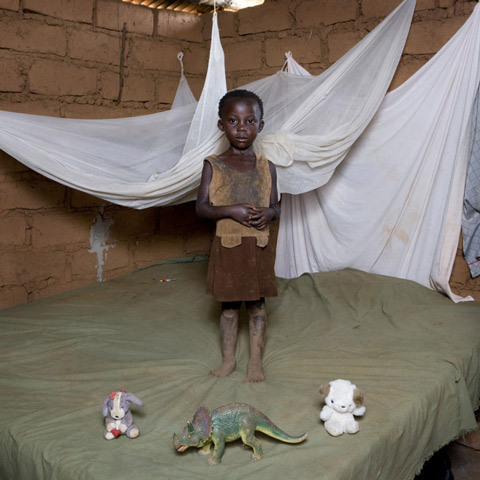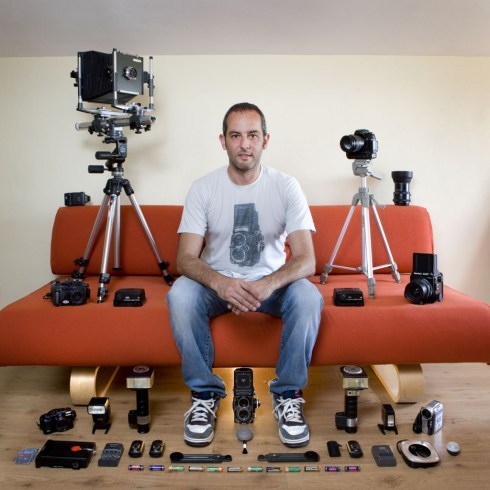Your Camera is Not a Toy: Photographing “Children From Around the World”
 In 1995 Dorling Kinderlsey published a book, Children Just Like Us, sponsored by UNICEF, which brought pictures of children from “all over the world” into the sheets between our fingers, complete with facts and direct quotations. The book feels friendly, ecumenical: children certainly have some funny habits and names, but underneath, of course, they are all alike! I wonder what effect these kind of books, which make faraway places and different cultures specularly available to Western children, have on the children who read them. Do they give those children a harmless, cosmopolitan, global outlook? Pseudo-anthropological ambitions, to travel, to see and know the world as benevolently different as it was promised? Or does it offer the Western child a dangerous sense of superiority? The cause of these thoughts are a photo-series of children with their toys, by an Italian photographer, Gabriele Galimberti.
In 1995 Dorling Kinderlsey published a book, Children Just Like Us, sponsored by UNICEF, which brought pictures of children from “all over the world” into the sheets between our fingers, complete with facts and direct quotations. The book feels friendly, ecumenical: children certainly have some funny habits and names, but underneath, of course, they are all alike! I wonder what effect these kind of books, which make faraway places and different cultures specularly available to Western children, have on the children who read them. Do they give those children a harmless, cosmopolitan, global outlook? Pseudo-anthropological ambitions, to travel, to see and know the world as benevolently different as it was promised? Or does it offer the Western child a dangerous sense of superiority? The cause of these thoughts are a photo-series of children with their toys, by an Italian photographer, Gabriele Galimberti.
“Every time he flew to some place foreign for his work, he’d find a local family and children happy to show him some of their favorite toys.” (PRI’s The World)
It sounds like happy work, traveling and taking photos of happy children with the happy consent of their happy families; Journalists have been eager to write about this work, which is so colourful and positive but also serious and thought-provoking, and many have used the opportunity to reflect uncritically on their own childhood possessions.
 In the most recent (and probably most shared) Feature Shoot post on Galimberti’s photographs (that’s him with his favorite toys all neatly laid out in the photo above), the leading image is that of a young child named Chiwa from Mchinji in Malawi.
In the most recent (and probably most shared) Feature Shoot post on Galimberti’s photographs (that’s him with his favorite toys all neatly laid out in the photo above), the leading image is that of a young child named Chiwa from Mchinji in Malawi.
I don’t want to describe the image – which takes its aesthetic of deprivation from charities and development organizations. Suffice to say, it’s the image at the top of this post. What seems more important is questioning the motivations and effects that this series – and the countless others like it, by “photojournalists,” trawling the world’s surface for their wage labour – has on its viewers and its subjects.
There is a kind of knee-jerk response to my concerns: that representations like these have positive, moral benefits: we become more aware of the lives of others in this world which we can’t help – thanks to environmental crises, trade, war, etc. – but share with everyone else in it, that this awareness, of complicity, is served by photographic representations of other places. That forgets the importance of attending to how these representations are made – and how they are used.
Let’s look carefully at the Feature Shoot article:
‘Galimberti explores the universality of being a kid amidst the diversity of the countless corners of the world; saying, “at their age, they are pretty all much the same; they just want to play.”’
The colloquial “universality of being a kid” is, of course, the journalist’s own journalistic prose, and the photographer can’t be held responsible for the incompetent idea of the complex problems of thinking ‘universally’. A piece on the series from The Times magazine rehearses the same platitudes about how toys tell you “everything you need to know about the universe kids inhabit”. The problem here is not ‘diversity’, but – just like the Dorling Kindersley book – assertions of similarity. They’re all just kids, right?
What is so persistently troubling about the kind of photojournalism which wins hearts and competitions from Western and cosmopolitan bodies is that the projects which win are frequently disguised by a kind of pseudo-anthropological discourse. See here, again from Feature Shoot:
“Galimberti found that children in richer countries were more possessive with their toys and that it took time before they allowed him to play with them (which is what he would do pre-shoot before arranging the toys), whereas in poorer countries he found it much easier to quickly interact, even if there were just two or three toys between them.”
It is important to note that the photographer himself arranged the toys. Forgetting the mountains of material by psychoanalysts or anthropologists which says that the person (or people) who are the subject of study should be approached on their own terms. Here the photographer arranges the toys, and the child, for the most perfect composition. James Mollison’s recent series on childrens rights, Where Children Sleep, and Mary Beth Meehan’s images of undocumented migrants, are both bodies of work which demonstrate a carefulness in encountering the photographic subject which is absent in these confrontations.
If some of the children know what to do for the camera and are smiling, the ones who look mournful or uncertain at why this strange man is pointing something at them, their toys – objects of intimate and complex relations – placed in strange new formations. The resistance to the photographer’s intentions, his invasion of private space, is the most valuable accident of this project, and the real source of difference.
What real difference is this series making manifest? The journalist recalls that the photographer recalls something vague about what the children did, making distinctions between rich countries and poor countries (which is, perhaps, forgetting that there are poor kids in rich countries, or vice versa).
“There were similarites too, especially in the functional and protective powers the toys represented for their proud owners. Across borders, the toys were reflective of the world each child was born into—economic status and daily life affecting the types of toys children found interest in. Toy Stories doesn’t just appeal in its cheerful demeanor, but it really becomes quite the anthropological study.” (Feature Shoot)
Quite the anthropological study! This phrase is exactly what a parent might patronisingly have said on finding their child looking at the Dorling Kindersley book. In this instance it is appropriately patronising: anthropology as a professional discipline has rigorous and necessary ways of thinking the problems of inter-cultural encounters, of thinking universally about education and commodification, subjectivity and difference, photojournalism like this seems governed, worryingly enough, by misguided and dangerous kind of good intentions.
The images of unsmiling children, looking back at the strange man who has entered into the private space of their fragile and critical object relations, remind us that the moralising gaze of the camera is not a disinterested thing. We might work harder to remember whose interests these cameras serve. What the photographer ultimately found (and was perhaps looking for all along) was a mirror on his own experience: telling the Times journalist, “It was nice to go back to my childhood somehow.” Adulthood must be a sad state to be in if you have to point a camera at a child when all you really want to do is play with them.

Sean Jacobs's Blog
- Sean Jacobs's profile
- 4 followers



